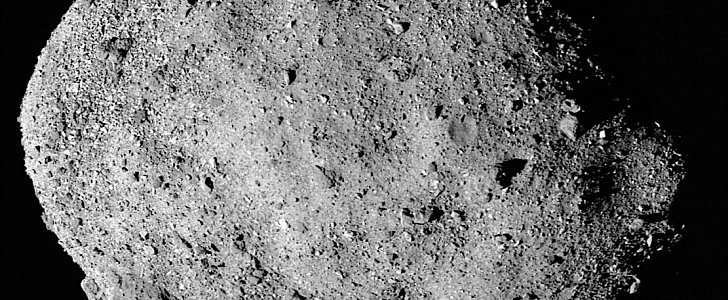Panspermia theory believers, rejoice! A fresh piece of evidence uncovered by NASA’s OSIRIS-REx spacecraft on an asteroid 1.4 million miles (2.2 million km) away from Earth shows the belief that life is abundant in the Universe thanks to space rocks is not at all that far-fetched.
The OSIRIS spaceship is now very close to the Bennu asteroid, from which it plans to pick up a sample and bring it back to Earth years from now. But before it gets to that, it already made a major discovery.
According to NASA, data gathered by the ship’s two spectrometers shows the asteroid has traces of molecules that contain oxygen and hydrogen atoms bonded together. This combo, called hydroxyls, is likely to exist across the asteroid in water-bearing clay minerals and point to the fact that the space rock had, at one point, interacted with water.
NASA believes Bennu, a carbonaceous primitive B-type asteroid, had some time in the past been part of a much larger body, one capable of holding liquid water.
“The presence of hydrated minerals across the asteroid confirms that Bennu, a remnant from early in the formation of the solar system, is an excellent specimen for the OSIRIS-REx mission to study the composition of primitive volatiles and organics,” said in a statement Amy Simon from the Goddard Space Flight Center.
“When samples of this material are returned by the mission to Earth in 2023, scientists will receive a treasure trove of new information about the history and evolution of our solar system.”
NASA plans to keep on looking closely at the surface of the asteroid and try to find the best location and timing to go in and pick up a sample.
OSIRIS is equipped with canisters which will release gas to make dust and pebbles. These particles will be picked up by the TAGSAM articulated arm, equipped with a round sampler at its top.
When enough asteroid material has been gathered, it will be deposited in a return capsule which is scheduled to start its voyage back home in March 2021.
According to NASA, data gathered by the ship’s two spectrometers shows the asteroid has traces of molecules that contain oxygen and hydrogen atoms bonded together. This combo, called hydroxyls, is likely to exist across the asteroid in water-bearing clay minerals and point to the fact that the space rock had, at one point, interacted with water.
NASA believes Bennu, a carbonaceous primitive B-type asteroid, had some time in the past been part of a much larger body, one capable of holding liquid water.
“The presence of hydrated minerals across the asteroid confirms that Bennu, a remnant from early in the formation of the solar system, is an excellent specimen for the OSIRIS-REx mission to study the composition of primitive volatiles and organics,” said in a statement Amy Simon from the Goddard Space Flight Center.
“When samples of this material are returned by the mission to Earth in 2023, scientists will receive a treasure trove of new information about the history and evolution of our solar system.”
NASA plans to keep on looking closely at the surface of the asteroid and try to find the best location and timing to go in and pick up a sample.
OSIRIS is equipped with canisters which will release gas to make dust and pebbles. These particles will be picked up by the TAGSAM articulated arm, equipped with a round sampler at its top.
When enough asteroid material has been gathered, it will be deposited in a return capsule which is scheduled to start its voyage back home in March 2021.

